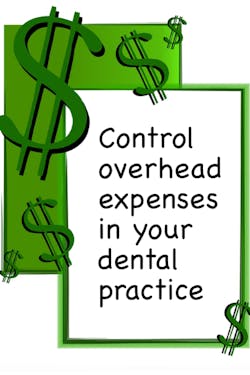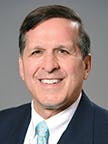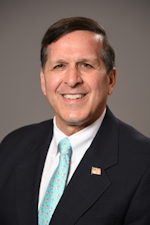This article originally appeared in the Principles of Practice Management e-newsletter. Subscribe to this informative twice monthly practice management ENL here.
Overhead is a key factor in any business, and dental practices are no exception. There was a time when dentists didn’t worry much about their overhead, as profit and profit margins were fairly stable and most practices grew at least a little bit each year. However, in this new era of dentistry with high levels of competition, low insurance reimbursements, and declining patient loyalty, overhead is a key part of your financial picture.
_________________________________________________________________________________________________________
Monitoring overhead
Your approach to monitoring overhead doesn’t need to be complicated. In fact, it should be very straightforward. Make a list of categories of expenses—the total expenses in that category month-to-date and year-to-date, and the percentage that category represents of total overhead. If the overhead adds up to 65% of practice revenue, then profit is 35% including all monies paid to you.
It helps to start with the largest overhead categories and the ones where you have the most control. An example is labor. It’s the single largest expense in most, if not all, dental practices. We recommend that labor be approximately 25% for a general practice including all benefits, bonuses, or excess staff compensation.
I recently counseled a doctor who had a 32.4% staff labor percentage, which is 7.4% above the recommended labor target. It meant that the practice was losing 7.4% of its profit margin due to the overpayment of labor. There were hard questions that needed to be asked and of course the most important one was, Why is staff labor so high? We discovered that despite the fact that the practice had declined in recent years, staff compensation and bonuses were continually increasing. This meant that the doctor was taking home less while the staff was receiving more without regard to market rates, etc.
After the hard questions came hard choices. After evaluating the practice and redistributing certain tasks and duties, the doctor was forced to eliminate a staff position. While this was a very difficult decision, it helped to bring the overhead labor target into alignment with the recommended rate and increase both the doctor’s income and practice’s efficiency.
Other key overhead categories
Other key overhead categories include rent, gas and electric, supplies, lab costs, accounting, marketing, equipment, and all other major investments. The best place to begin is to analyze the categories with the highest percentages of revenue. For example, rent should be 6%–7% of revenue, lab costs 6%, supplies 6%, marketing 2%–3%, accounting 1%–2%, and so on. As you analyze each category, benchmark them against national averages and determine how the practice stacks up against all these comparatives. Categories that run high should be evaluated to determine why they are higher than expected, and then brought into line.
Keep in mind that for every 1% overhead goes down, profit goes up by the same 1%. Conversely, as revenue declines the percentage of each overhead category increases. However, this can give a skewed picture of the practice situation and you must be careful not to reduce each overhead category simply because it’s above national averages.
There are times when making a large change in one category can bring the total overhead where it needs to be. We recently worked with a practice where all overhead categories were above the national average, but we found that the departure of two team members would bring total overhead into line, reducing it from 69%–62.7%.
Whatever decisions you make, be careful the adjustments do not hurt the daily performance of the practice. As the saying goes, you get what you pay for. If you change laboratory vendors to reduce costs but your level of efficiency and accuracy drops, it’s just not worth it.
Overhead is a critical factor in practice profitability. Dentists must focus on their overhead monthly and annually in order to understand its exact effect on the practice. Analyzing overhead will help practice leaders make the decisions necessary to keep control of expenditures and ensure practice success.
Roger P. Levin, DDS, is executive founder of Dental Business Study Clubs, dentistry’s only all-business study clubs, the next generation of dental business education. For more information, call (833) DBSCLUBS or visit dbsclubs.com.









